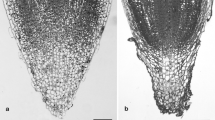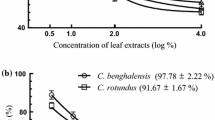Abstract
The relative effect of parthenium (Parthenium hysterophorus L.) plant residue on growth of salvinia and paddy seedlings was studied. The inhibitory activity of the residue as shown by its effect on the number of healthy fronds (HFN) and biomass was in the order: flower and leaf > stem and root. The flower (FP) and leaf (LP) residue was lethal at and above 0.75% (w/v, the convention used throughout), and inhibitory at lower doses. The stem (SP) and root (RP) residue supported growth of salvinia at lower doses and were slightly inhibitory at higher (1.25%) dose. All the above residue types supported the growth of paddy seedlings except at 1.25%, the highest concentration tested, which was slightly inhibitory. The amounts of chlorophylla, b, total chlorophyll, and carotenoid pigments in the leaves of the paddy seedlings grown in the medium were comparable to the amounts in the leaves of seedlings grown in distilled water. This demonstrates beneficial effects of the treatments. The study shows that salvinia is more sensitive to allelochemicals released by FP and LP into the aqueous medium. Both salvinia and paddy responded similarly to SP and RP by supporting growth at lower doses, probably due to lower levels of inhibitors. The results are discussed with reference to the possible role of allelopathy by parthenium on the population dynamics of aquatic weeds in natural ecosystems.
Similar content being viewed by others
References
Anonymous. 1985. International rules for seed testing. International Seed Testing Association.Seed Sci. Technol. 13:356–513.
Arnon, D.I. 1949. Copper enzymes in isolated chloroplast. Polyphenol oxidase inBeta vulgaris.Plant Physiol. 24:1–15.
Canal Villanueva, M.J., Muniz, B.F., andTames, R.S. 1985. Effects of glyphosate on growth and the chlorophyll and carotenoid levels of yellow nutsedge (Cyperus esculentus).Weed Sci. 33:751–754.
Jain, R., Singh, M., andDezman, D.J. 1989. Qualitative and quantitative characterization of phenolic compounds from lantana (Lantana camara) leaves.Weed Sci. 37:302–307.
Kanchan, S.D., andJayachandra. 1980. Allelopathic effects ofParthenium hysterophorus L. IV. Identification of inhibitors.Plant Soil 55:67–75.
Pandey, D.K. 1994. Inhibition of salvinia (Salvinia molesta Mitchell) by parthenium (Parthenium hysterophorus L.). I. Effect of leaf residue and allelochemicals.J. Chem. Ecol. 20:000-000.
Pandey, D.K., Kauraw, L.P., andBhan, V.M. 1993a. Inhibitory effect of Parthenium (Parthenium hysterophorus L.) residue on growth of water hyacinth (Eichhornia crassipes Mart Solms.) I. Effect of leaf residue.J. Chem. Ecol. 19:2651–2662.
Pandey, D.K., Kauraw, L.P., andBhan, V.M. 1993b. Inhibitory effect of parthenium (Parthenium hysterophorus L.) residue on growth of water hyacinth (Eichhornia crassipes Mart Solms.) II. Relative effect of flower, leaf, stem, and root residue.J. Chem. Ecol. 19:2663–2670.
Picman, J., andPicman, A.K. 1984. Autotoxicity inParthenium hysterophorus and its possible role in control of germination.Biochem. Syst. Ecol. 12:287–292.
Swain, T., andHillis, W.E. 1959. The phenolic constituents ofPrunus domestica. I. The quantitative analysis of phenolic constituents.J. Sci. Food Agric. 10:63–68.
Towers, G.H.N., Mitchell, J.C., Rodriguez, E., Bennett, F.D., andSubbarao, P.V. 1977. Biology and chemistry ofParthenium hysterophorus L., a problem weed in India.J. Sci. Ind. Res. 36:672–684.
Author information
Authors and Affiliations
Rights and permissions
About this article
Cite this article
Pandey, D.K. Inhibition of salvinia (Salvinia molesta Mitchell) by parthenium (Parthenium hysterophorus L.). II. Relative effect of flower, leaf, stem, and Root residue on Salvinia and Paddy. J Chem Ecol 20, 3123–3131 (1994). https://doi.org/10.1007/BF02033715
Received:
Accepted:
Issue Date:
DOI: https://doi.org/10.1007/BF02033715




